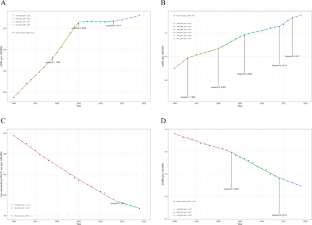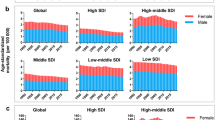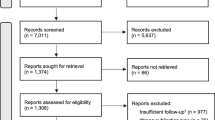Abstract
Background
Intestinal obstruction (IO) is a common surgical acute abdominal condition that places a significant burden on modern health systems. Unfortunately, the global burden and trends of IO remain unknown. Therefore, this study aimed to comprehensively assess its long-term trends and epidemiological features, which will help policymakers to formulate appropriate health policies.
Methods
We conducted an ecological study using data from the Global Burden of Disease Study (GBD) 2019. Data on IO were analyzed by sex, age, year, sociodemographic index (SDI), and location according to GBD 2019. In addition, joinpoint regression analysis was used to assess temporal trends. Age-period-cohort analysis (APC Analysis) was conducted to evaluate age, period, and birth cohort effects on IO incidence and mortality risk.
Results
Globally, the prevalent and incident cases increased by 56.91% and 86.67% from 1990 to 2019, respectively. Joinpoint regression analysis showed that age-standardized incidence rate (ASIR) and age-standardized prevalence rate (ASPR) increased, but age-standardized mortality rate (ASMR) and age-standardized disability-adjusted life year (DALY) rate decreased over the past three decades. The age effect demonstrated that older people have a higher risk of morbidity and mortality. The period effect of incidence and mortality showed an upward trend from 1990 to 2019. Cohort effect revealed that the incidence and death risk peaked in the earlier-born cohort and was lower in the more recent-born cohort. Notably, we found that the burden of IO was higher in males than in females throughout the study period. There are huge disparities in IO burden among countries.
Conclusion
Globally, the reported incidence and prevalence of IO increased from 1990 to 2019. The burden of IO differed markedly by age, sex, country, and region. Middle-aged and elderly people over 50 years old were at high risk. Given the ageing population, the burden of IO will be a major public health challenge. Thus, there is a strong necessity to strengthen prevention and early intervention in the at-risk population.






Similar content being viewed by others
Data availability
The original contributions presented in the study are included in the article/Supplementary Material; further inquiries can be directed to the corresponding author/s.
References
Jackson PG, Raiji MT (2011) Evaluation and management of intestinal obstruction. Am Fam Physician 83(2):159–165
Bower KL, Lollar DI, Williams SL et al (2018) Small bowel obstruction. Surg Clin North Am 98(5):945–971. https://doi.org/10.1016/j.suc.2018.05.007
Vilz TO, Stoffels B, Strassburg C, Schild HH, Kalff JC (2017) Ileus in adults. Dtsch Arztebl Int 114(29–30):508–518. https://doi.org/10.3238/arztebl.2017.0508
Cappell MS, Batke M (2008) Mechanical obstruction of the small bowel and colon. Med Clin North Am 92(3):575–597, viii. https://doi.org/10.1016/j.mcna.2008.01.003
Gao XH, Chouhan H, Gorgun E, Stocchi L, Ozuner G (2018) Comparisons of the surgical outcomes and medical costs between transferred and directly admitted patients diagnosed with intestinal obstruction in an American tertiary referral center. Int J Colorectal Dis 33(11):1617–1625. https://doi.org/10.1007/s00384-018-3052-4
Zhang D, Liu S, Li Z, Wang R (2022) Global, regional and national burden of gastroesophageal reflux disease, 1990–2019: update from the GBD 2019 study. Ann Med 54(1):1372–1384. https://doi.org/10.1080/07853890.2022.2074535
Gu WJ, Pei JP, Lyu J et al (2022) The burden of early-onset colorectal cancer and its risk factors from 1990 to 2019: a systematic analysis for the Global Burden of Disease Study 2019. Cancers (Basel) 14(14). https://doi.org/10.3390/cancers14143502
Xing QQ, Li JM, Dong X et al (2022) Socioeconomics and attributable etiology of primary liver cancer, 1990–2019. World J Gastroenterol 28(21):2361–2382. https://doi.org/10.3748/wjg.v28.i21.2361
GBD 2019 Demographics Collaborators (2020) Global age-sex-specific fertility, mortality, healthy life expectancy (HALE), and population estimates in 204 countries and territories, 1950–2019: a comprehensive demographic analysis for the Global Burden of Disease Study 2019. Lancet 396(10258):1160–1203. https://doi.org/10.1016/S0140-6736(20)30977-6
Safiri S, Carson-Chahhoud K, Noori M et al (2022) Burden of chronic obstructive pulmonary disease and its attributable risk factors in 204 countries and territories, 1990–2019: results from the Global Burden of Disease Study 2019. BMJ 378:e069679. https://doi.org/10.1136/bmj-2021-069679
Weston BW, Swingen ZN, Gramann S, Pojar D (2022) SAFER model: strategic allocation of fundamental epidemic resources. J Public Health (Oxf) 44(2):228–233. https://doi.org/10.1093/pubmed/fdaa179
GBD 2019 Diseases and Injuries Collaborators (2020) Global burden of 369 diseases and injuries in 204 countries and territories, 1990–2019: a systematic analysis for the Global Burden of Disease Study 2019. Lancet 396(10258):1204–1222. https://doi.org/10.1016/S0140-6736(20)30925-9
Liu Z, Jiang Y, Yuan H et al (2019) The trends in incidence of primary liver cancer caused by specific etiologies: results from the Global Burden of Disease Study 2016 and implications for liver cancer prevention. J Hepatol 70(4):674–683. https://doi.org/10.1016/j.jhep.2018.12.001
Sharma R, Rakshit B (2023) Spatial and temporal patterns of colorectal cancer in Asia, 1990–2019. Int J Clin Oncol 28(2):255–267. https://doi.org/10.1007/s10147-022-02274-x
GBD 2019 Cancer Risk Factors Collaborators (2022) The global burden of cancer attributable to risk factors, 2010–19: a systematic analysis for the Global Burden of Disease Study 2019. Lancet 400(10352):563–591. https://doi.org/10.1016/S0140-6736(22)01438-6
Ojha U, Marshall DC, Salciccioli JD et al (2022) Temporal trend analysis of rheumatic heart disease burden in high-income countries between 1990 and 2019. Eur Heart J Qual Care Clin Outcomes. https://doi.org/10.1093/ehjqcco/qcac083
Paik JM, Kabbara K, Eberly KE, Younossi Y, Henry L, Younossi ZM (2022) Global burden of NAFLD and chronic liver disease among adolescents and young adults. Hepatology 75(5):1204–1217. https://doi.org/10.1002/hep.32228
Zhang Y, Liu J, Han X et al (2022) Long-term trends in the burden of inflammatory bowel disease in China over three decades: a joinpoint regression and age-period-cohort analysis based on GBD 2019. Front Public Health 10:994619. https://doi.org/10.3389/fpubh.2022.994619
Hu W, Fang L, Zhang H, Ni R, Pan G (2022) Global disease burden of COPD from 1990 to 2019 and prediction of future disease burden trend in China. Public Health 208:89–97. https://doi.org/10.1016/j.puhe.2022.04.015
Li Y, Ren N, Zhang B et al (2023) Gastric cancer incidence trends in China and Japan from 1990 to 2019: disentangling age-period-cohort patterns. Cancer 129(1):98–106. https://doi.org/10.1002/cncr.34511
Traeger L, Koullouros M, Bedrikovetski S et al (2022) Cost of postoperative ileus following colorectal surgery: a cost analysis in the Australian public hospital setting. Colorectal Dis 24(11):1416–1426. https://doi.org/10.1111/codi.16235
Millan M, Biondo S, Fraccalvieri D, Frago R, Golda T, Kreisler E (2012) Risk factors for prolonged postoperative ileus after colorectal cancer surgery. World J Surg 36(1):179–185. https://doi.org/10.1007/s00268-011-1339-5
Watkins EL, Schellack N, Abraham V, Bebington B (2021) Men and those with a history of smoking are associated with the development of postoperative ileus following elective colorectal cancer resection at a private academic hospital in Johannesburg, South Africa: a retrospective cohort study. Front Surg 8:667124. https://doi.org/10.3389/fsurg.2021.667124
Venara A, Meillat H, Cotte E et al (2020) Incidence and risk factors for severity of postoperative ileus after colorectal surgery: a prospective registry data analysis. World J Surg 44(3):957–966. https://doi.org/10.1007/s00268-019-05278-3
Koch KE, Hahn A, Hart A et al (2021) Male sex, ostomy, infection, and intravenous fluids are associated with increased risk of postoperative ileus in elective colorectal surgery. Surgery 170(5):1325–1330. https://doi.org/10.1016/j.surg.2021.05.035
Atalay M, Gebremickael A, Demissie S, Derso Y (2021) Magnitude, pattern and management outcome of intestinal obstruction among non-traumatic acute abdomen surgical admissions in Arba Minch General Hospital, Southern Ethiopia. BMC Surg 21(1):293. https://doi.org/10.1186/s12893-021-01294-0
Twahirwa I, Ndayiragije C, Nyundo M, Rickard J, Ntaganda E (2022) Pediatric intestinal obstruction: analysis of etiologies and factors influencing short-term outcomes in Rwanda. World J Pediatr Surg 5(4):e000424. https://doi.org/10.1136/wjps-2022-000424
Adeyemi D (1989) Neonatal intestinal obstruction in a developing tropical country: patterns, problems, and prognosis. J Trop Pediatr 35(2):66–70. https://doi.org/10.1093/tropej/35.2.66
Elgar G, Smiley P, Smiley A, Feingold C, Latifi R (2022) Age increases the risk of mortality by four-fold in patients with emergent paralytic ileus: hospital length of stay, sex, frailty, and time to operation as other risk factors. Int J Environ Res Public Health 19(16). https://doi.org/10.3390/ijerph19169905
Acknowledgements
Thanks to Xiao Ming (Xiaoming_room@hotmail.com) for his work in the GBD database. His excellent sharing of GBD database analysis procedure and other public database makes it easier for us to explore the GBD database. The authors also thank Jun Xu and Yidan Tong for their assistance with language and the reviewers for allowing us to make improvements to the manuscript.
Funding
This study was supported by grants from the National Natural Science Foundation of China (81874466, 81904176), Natural Science Foundation of Hunan Province (2021JJ30531, 2023JJ60044), Scientific Research Foundation of Hunan Provincial Department of Education (21B0389), Hunan Province Administration of Traditional Chinese Medicine (B2023079), Clinical Medical Technology Innovation Guide Project of Hunan Province (2021SK51413), and Construction Project of Inheritance Studio of National Famous Traditional Chinese Medicine Experts ([2022] No. 75).
Author information
Authors and Affiliations
Contributions
DL and CM contributed to the concept, design, and manuscript writing. DL and CM were responsible for literature search, data acquisition, data analysis, and statistical analysis. YL contributed to data acquisition, supervision, and edited the manuscript. TZ provided valuable suggestions for data analysis and figure design. YX and YZ reviewed the manuscript. All authors read and approved the final manuscript.
Corresponding authors
Ethics declarations
Conflict of interest
The authors declare no competing interests.
Additional information
Publisher's Note
Springer Nature remains neutral with regard to jurisdictional claims in published maps and institutional affiliations.
Dan Long and Chenhan Mao have contributed equally to this work.
Supplementary Information
Below is the link to the electronic supplementary material.
Rights and permissions
Springer Nature or its licensor (e.g. a society or other partner) holds exclusive rights to this article under a publishing agreement with the author(s) or other rightsholder(s); author self-archiving of the accepted manuscript version of this article is solely governed by the terms of such publishing agreement and applicable law.
About this article
Cite this article
Long, D., Mao, C., Liu, Y. et al. Global, regional, and national burden of intestinal obstruction from 1990 to 2019: an analysis from the Global Burden of Disease Study 2019. Int J Colorectal Dis 38, 245 (2023). https://doi.org/10.1007/s00384-023-04522-6
Accepted:
Published:
DOI: https://doi.org/10.1007/s00384-023-04522-6




